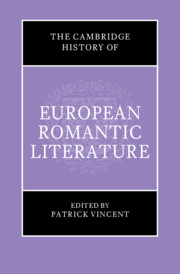Book contents
- The Cambridge History of European Romantic Literature
- The Cambridge History of European Romantic Literature
- Copyright page
- Contents
- Contributors
- Acknowledgements
- Note on the Text
- Chronology
- Introduction
- Part I Romantic Genealogies (1750–1790)
- Part II Revolution to Restoration (1790–1815)
- 7 Transcendental Revolutions
- 8 Citizens of the World
- 9 Romantic Loss, Emigration, and Exile
- 10 Women Writers’ Networks
- 11 Romantic Nationalisms
- 12 Shakespeare and Romantic Drama
- 13 Classics and Romantics
- Part III Restoration to Revolution (1815–1850)
- Further Reading
- Index
7 - Transcendental Revolutions
from Part II - Revolution to Restoration (1790–1815)
Published online by Cambridge University Press: 10 January 2024
- The Cambridge History of European Romantic Literature
- The Cambridge History of European Romantic Literature
- Copyright page
- Contents
- Contributors
- Acknowledgements
- Note on the Text
- Chronology
- Introduction
- Part I Romantic Genealogies (1750–1790)
- Part II Revolution to Restoration (1790–1815)
- 7 Transcendental Revolutions
- 8 Citizens of the World
- 9 Romantic Loss, Emigration, and Exile
- 10 Women Writers’ Networks
- 11 Romantic Nationalisms
- 12 Shakespeare and Romantic Drama
- 13 Classics and Romantics
- Part III Restoration to Revolution (1815–1850)
- Further Reading
- Index
Summary
Kant’s famous comparison of his transcendental critique to a revolution serves as the departure point for Nicolas Halmi’s chapter, which also explores the powerful conjunction between philosophy, criticism, and poetry in early German and British Romanticism, marked by acute self-consciousness. Halmi first discusses changes in the concept of revolution, and how the new meaning lent itself to politics and to philosophy, which both sought to give the subject greater autonomy and self-governance. He then examines different theories developed in response to Kant but also to the Revolution and its perceived failure, many of which call for a moral and intellectual revolution of the self as a preparation for democratic reform. These include Fichte’s theory of scientific knowledge, Schiller’s aesthetic education, Friedrich Schlegel’s transcendental poetry, and Shelley’s defence of the poetic imagination as a source of moral sympathy. Key ideas presented in the chapter include Bildung, the Absolute, Wechselerweis, romantic irony, and allegory. Halmi concludes with a section on Wordsworth’s poetic reform in the Lyrical Ballads, arguing that it emerged as a conservative reaction to revolution.
Keywords
- Type
- Chapter
- Information
- The Cambridge History of European Romantic Literature , pp. 223 - 254Publisher: Cambridge University PressPrint publication year: 2023

